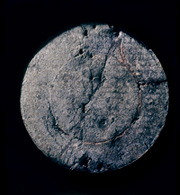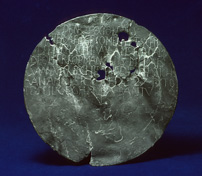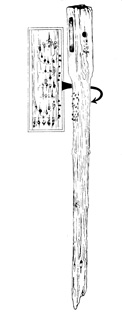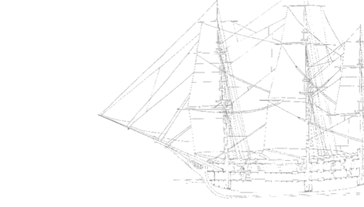
| European seafarers often left traces
of their presence on the distant shores they visited. In October
1616, skipper Dirk Hartog and the crew from the Dutch ship Eendracht (Unity) left a flattened pewter plate nailed to a wooden post at
the north end of what became known as Dirk Hartog Island. Hartog’s
plate served as proof that he visited Shark Bay on his voyage should
he not return home.
The stretch of coast that Hartog discovered was entered in the files of the Verenigde Oostindische Compagnie (VOC) as the ‘Land of Endracht’. While the loss of the VOC retourschip Batavia on the dangerous reefs of the Houtman Abrolhos in 1629 made vessels wary of the west coast of Australia, they soon learned that ‘Dirk Hartog’s Roads’ at Shark Bay offered good anchorage.
‘The land which we saw…and the land which we were near to at noon Dirck Hartochsz-Roads, for we had before us a large bay or bight between two capes. In the bay we could see no land from the main-topmast, but so far as we could discern the surf ran through the whole bay from one cape to another. The land shows various white plots near the seaside, and in many places rises very steeply so far as we could see. The breakers on the coast were very strong, but there were no rocks or shallows near the coast on which we could see the surf break, except at the cape north of Dirk Hartochs Roads… …we kept sounding every two or three glasses during the whole night until sunrise and found 80 fathoms sandy bottom…’ Journal of Commander Wollebrand Geleynszoon De Jongh of the ship Amsterdam 1635. The Hartog & De Vlamingh Plates Both plates have had dramatic histories and are priceless relics of the earliest explorations of Australia. 25 October 1616 – Dirk Hartog nailed a pewter plate to a post with an engraved account of his voyage and his crew.
He copied the inscriptions and erected a new post for the plate and nailed a Dutch flag to the post. He also left an engraved lead plaque commemorating the Baudin expedition, which has never been found. September 1818 – Captain Louis de Freycinet arrived on Uranie determined to recover the plate he had seen with Hamelin. He took the plate with him giving it to the Academie Royale des inscriptions et belle-lettres de l’Institute de France in Paris for safekeeping. It wasn’t until 1940 that is was rediscovered in these collections by Francois Renie, who published an extensive description of the plate after the German occupation. 28 May 1947 – The French Government presents the plate to Australia. The plate returns to Western Australia in 1950 to become part of the Western Australian Museum collection. It is on permanent exhibition at the Western Australian Museum – Shipwreck Galleries in Fremantle. Cape Inscription Posts 25 October 1616 – Dirk Hartog erected a post, believed to be made of oak to hold the pewter plate recording his journey. 4 February 1697 – Willem de Vlamingh replaces Hartog’s post. This post is believed to have been made from Rottnest Island ‘pine’, identified in 1822 by Phillip Parker King’s botanist Alan Cunningham.
2006 – The Dirk Hartog Landing Site 1616- Cape Inscription Area was added to the National Heritage List. Click Here to go to the next page. |











